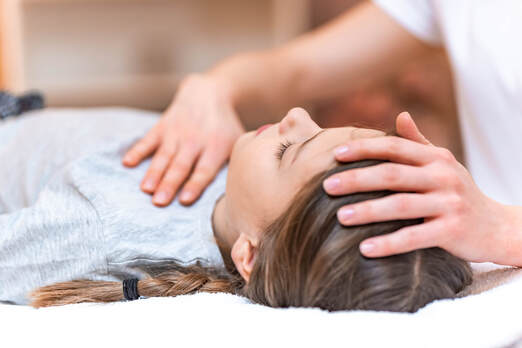Osteopathic manipulative treatment (OMT) is an all-encompassing evaluation of the body using specific techniques. OMT aims to provide a hand on, holistic approach to the prevention, diagnosis, and treatment of an injury or illness. Osteopathic medicine focuses on the interdependence of the body systems, emotions, mentality, and spirituality and understanding how the parts impact the whole and vice versa. When performing OMT, a physician will manipulate, or apply manual pressure to, specific muscles, tissue, and joints. OMT works with the inherent motions in the body to release restrictions and re-synchronize all elements of the body, resolving pain and dysfunction. OMT provides patients with relief and, generally, resolution from pain, while encouraging self-healing of the body and an improvement in function and mobility. OMT can also be paired with certain medications or surgery to aid in a safer and stronger recovery. This full person approach is beneficial to the patient as it creates a comprehensive and effective treatment.
Who Does OMT Benefit?
OMT can be beneficial to all ages, from infants to the elderly. OMT is specifically designed to be easily adjusted to meet the needs of each individual patient, regardless of their condition. There have been a wide variety of health problems, which will be discussed in further detail later, that OMT has been known to treat. These range from muscle pain to menstrual pain or asthma.
Where to Receive OMT
OMT is practiced by Doctors of Osteopathic Medicine (DOs). DOs are licensed physicians that have both traditional medical training and special hands-on training for techniques involving manipulation of the musculoskeletal system. DOs focus on utilizing a holistic approach when addressing any medical problems to help patients maintain peak health of the mind, body, and spirit. The combination of conventional medical training and OMT allows DOs to accomplish this goal.
Specific Applications of OMT
OMT can be used for a wide range of injuries and illnesses. Below are just a few of the many uses of OMT. This treatment is also beneficial to restore muscle balance, improve blood flow in the body, and relieve joint misalignment. OMT is also often used to address sports injuries or other chronic issues.
Lower Back Pain
Chronic lower back pain is a disability impacting millions of Americans each year. At any one point in time, it is estimated that 2% of the US population is disabled as a result of back issues. DOs use osteopathic techniques for spinal manipulation to relieve lower back pain. A controlled trial determined that compared to the control subjects, those that received OMT reported back greater improvement in the level of back pain and better functioning overtime. Another stratified analysis determined a decrease in pain when OMT was applied compared to a placebo or no treatment control group, in both the United States and the United Kingdom. Through OMT techniques, muscle tension decreases and joint movement is increased. Through palpation the underlying affected areas are determined, which allows DOs to relieve pain via kneading, applying pressure, stretching, and activating certain muscles.
During pregnancy, lower back pain is a common complaint that can impact daily activities and quality of life. OMT targeted for the lumbar region can be used to alleviate some of this back pain. In a randomized, placebo-controlled trial of women in their 3rd trimester of pregnancy the results indicated that OMT decreased back pain. While further research is needed in a clinical setting to determine the direct benefits of OMT, present research suggests that OMT creates positive results in patients.
Migraines
In the US, it has been reported that approximately 36 million Americans (18% of women and 6% of men) suffer from migraines. Migraines are recurring headaches that can cause a range of pain in either a throbbing or pulsing manner. Many times, conventional methods do not result in pain relief for those suffering from chronic migraines. OMT provides a non-invasive, low risk, holistic treatment for migraines. There are several ways that OMT can be applied to provide relief from migraines. One way is thought correcting somatic dysfunctions that are based on the head or neck region of the body. Manipulation of the fascia around cranial bones could provide relief, as the nervous and nervous tissue in their area faces fewer restrictions and gains function. It has also been theorized that OMT improves lymphatic flow, blood flow, and fluid drainage in the face, neck, and cranium which could result in increased oxygen and nutrients to these specific areas and relieve pain, as pressure decreases. By addressing issues that may result in headaches or migraine, such as sinusitis, OMT can be utilized to combat the root source of this pain. The aforementioned strategies of improving blood and lymphatic flow can reduce tension in the muscles of the head and neck, which are often the cause of tension headaches. A study conducted in 2011 determined that OMT as a migraine treatment produced decreased pain intensity and decreased the amount of time the migraine persisted when compared to a control which was not treated using osteopathic manipulation.
Asthma
Many pediatric patients have the chronic condition of asthma. OMT is used as a non-invasive treatment for pediatric patients. The therapeutic effects of OMT were shown in a randomized controlled trial, which showed statistical significance when comparing pediatric patients that participated in OMT and those that did not. OMT techniques are able to increase vital capacity in patients and increase rib cage mobility. By focusing on these areas of the body, these techniques can be used to increase the effectiveness of the respiratory cycle which in turn improves ability to breath. It is also important to note that the traditional treatment through pharmacological therapy does not take into consideration the musculoskeletal aspects of breathing, whereas OMT focuses on this component.

 RSS Feed
RSS Feed